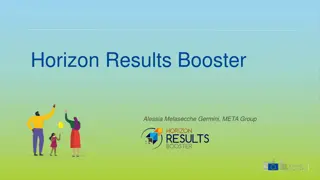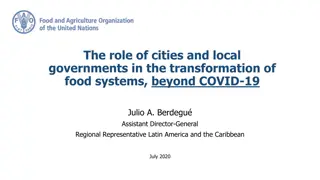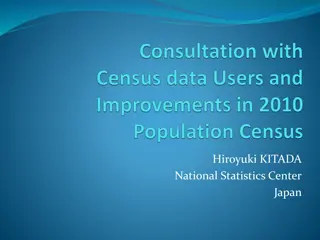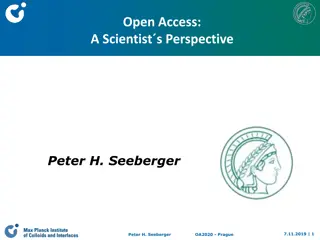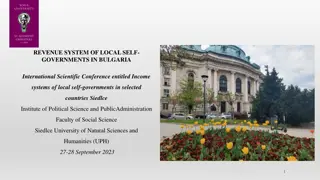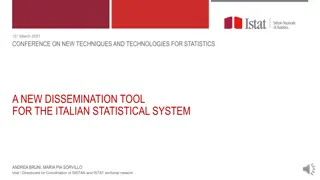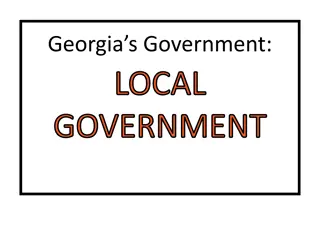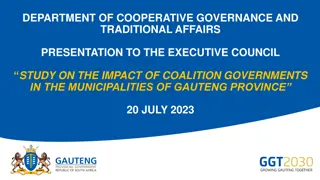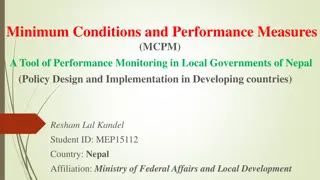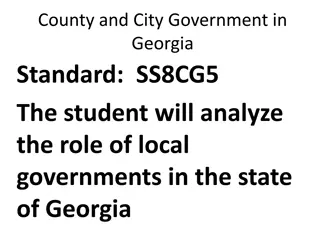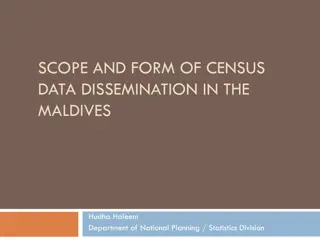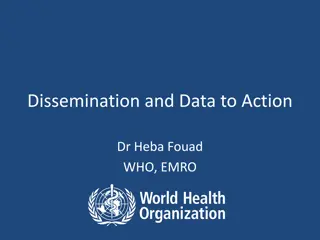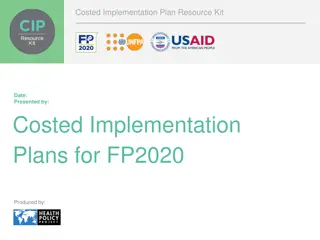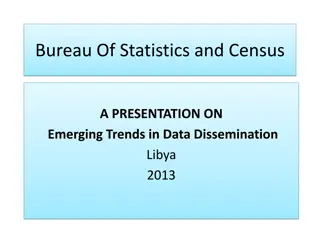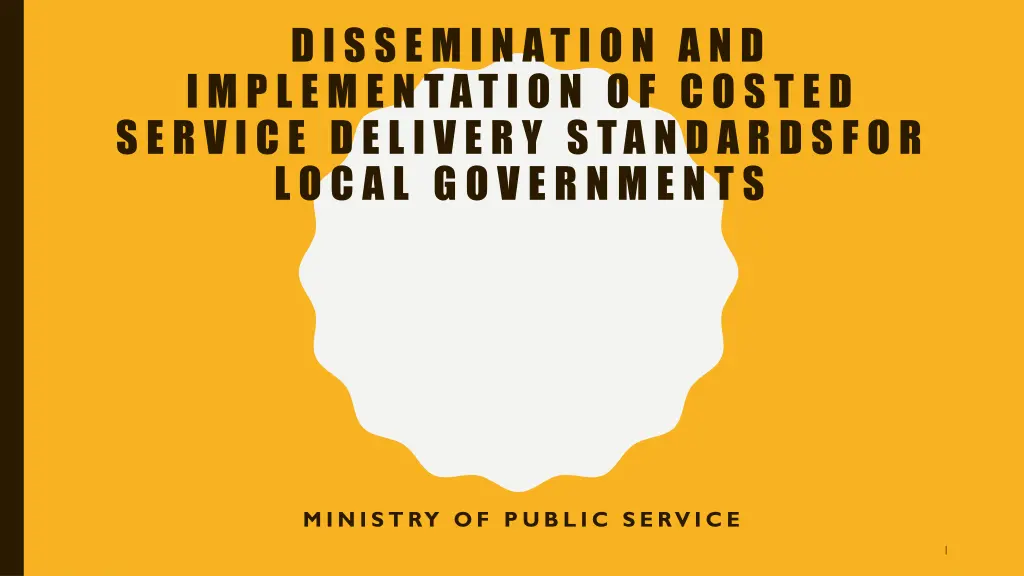
Implementation of Service Delivery Standards in Uganda Public Service
Discover how the Ministry of Public Service in Uganda introduced service delivery standards in 2011, aimed at improving public service efficiency and effectiveness. Learn about the various types of standards, their classifications, and the benefits they bring to the public sector.
Uploaded on | 0 Views
Download Presentation

Please find below an Image/Link to download the presentation.
The content on the website is provided AS IS for your information and personal use only. It may not be sold, licensed, or shared on other websites without obtaining consent from the author. If you encounter any issues during the download, it is possible that the publisher has removed the file from their server.
You are allowed to download the files provided on this website for personal or commercial use, subject to the condition that they are used lawfully. All files are the property of their respective owners.
The content on the website is provided AS IS for your information and personal use only. It may not be sold, licensed, or shared on other websites without obtaining consent from the author.
E N D
Presentation Transcript
D ISSEM INATIO N A ND IM P L EM ENTATIO N O F CO STED SERVICE DEL IVERY STANDARDSF OR LO CA L G O VERNM ENTS MINISTRY OF PUBLIC SERVICE 1
INTRODUCTION INTRODUCTION The Ministry of Public Service introduced service delivery standards to the Service vide Establishment Notice No 3 of 2011, which elaborated and spelt out implementation guidelines for development, documentation and dissemination of standards. These guidelines were later reviewed and re-issued in 2021. This followed various recommendations for improving the functioning of the public service that were made by the Public Service Review and Re-Organization Commission (PSRRC) which Government had Instituted in 1988 The guidelines required and guided all Ministries, Departments, Agencies and Local Governments (MDAs & LGs) to develop, document, disseminate and implement Service Delivery Standards, which Local Governments (MDAs & LGs). 2
WHAT ARE SERVICE DELIVERY WHAT ARE SERVICE DELIVERY STANDARDS THEN? STANDARDS THEN? In the context of the Uganda Public Service, Service Delivery Standards refer to : a) The minimum level of expected services in terms of quality, quantity, processes, time, cost and coverage that a Programme, an institution or individual commits to deliver to their clients or those that the clients should expect to receive; b) The established, accepted and evidence-based technical specifications or basis for comparison; and c) The norms, standard operating procedures, protocols, baselines or charters which are the minimum requirements that institutions must adhere to. 3
CLASSIFICATION OF STANDARDS; CLASSIFICATION OF STANDARDS; Service delivery standards in the Uganda Public Service are classified as follows: Professional Standards. Ethical or legal duties of a professional to exercise the level of care, diligence and skill prescribed in the code of practice of a profession or standards of professional business conduct that largely concern effective management of processes, systems and records. Technical Standards Specifications or requirements for materials, performance, products or services. A technical standard is an established norm or requirement in regard to technical systems. It is usually a formal catalogue of technical criteria, methods, processes and practices. Process standards Business process or procedure a service provider or recipient has to follow in order to access or produce a service. Process standards are not specific to a particular discipline, but are generic to any discipline. 4
BENEFITS OF SERVICE DELIVERY BENEFITS OF SERVICE DELIVERY STANDARDS IN THE PUBLIC SERVICE STANDARDS IN THE PUBLIC SERVICE Development, documentation and dissemination of service delivery standards will: Improve citizens access to information on services delivered and enhance capacity of citizens to demand service Enhance the Planning and Budgeting process Enhance public service performance and accountability. Provide uniformity in the delivery of services at the National and Local levels. Promote coordination and synergy at National, Sector and Local levels. Business process re-engineering to achieve efficiency and effectiveness Trigger social and economic improvement through equitable access to and control of resources. Promote equity for marginalized groups. 5
A case for documenting service delivery standards Service Excellence - Our Prime Focus Level of service Uniformity To provide uniformity and consistence in the provision of services both at National and Local Government level Planning To provide a yardstick for developing Institutional plans & budgets, client charters, man-power forecast and determine minimum budgets and cost for providing a service . 01 02 03 Define the minimum level of service that Government should provide and what service recipients should expect in terms of time ,quality , quantity , cost and coverage Citizen empowerment To empower service recipients and communities to demand for services which are due to them at the appropriate standard and provide a basis upon which levels of satisfaction with standards can be evaluated. Process re-engineering To provide a basis for the review of management systems and processes. 04 05 06 Enforcing compliance To enforce quality assurance and compliance mechanisms for service delivery against local, national and international standards and best practices. 6
PRINCIPLES FOR APPLICATION OF SERVICE DELIVERY STANDARDS Client focus: focusing on needs that reflect priorities/needs of service recipients Professionalism: adherence to the Public Service code of conduct and ethics, Professional code of conduct, exhibiting a high degree of competence and best practices. Transparency: openness about all the decisions and actions taken Accountability: public trust and responsibility for actions taken or not taken. Cost efficiency: optimal use of resources including time in attainment of service delivery objectives. This should include user charges where applicable. 7
PRINCIPLES FOR APPLICATION OF SERVICE DELIVERY STANDARDS Effectiveness: achieving the intended results in terms of quality and quantity in accordance with set targets and performance standards for service delivery Participation: involving partners in the design, implementation, monitoring and evaluation of service delivery. These should include Government Institutions, Local Governments, Civil Society, Development Partners, the Private Sector and the general public. Equity: fair treatment to all customers irrespective of gender, race, religion, disability, ethnic background and political affiliation 8
LEVELS AND SOURCES LEVELS AND SOURCES OF SERVICE DELIVERY STANDARDS. DELIVERY STANDARDS. Level Criteria of determination OF SERVICE International/Regional Level These are standards that have been developed basing on internationally recognized service delivery standards and best practices. These are determined on the basis of Government policy and legal requirements, development objectives and national priorities. It is good practice to benchmark national standards against international service delivery standards. Each Sector or institution for example the Education Sector, Health Sector etc. should aspire to achieve a level of service provision for its clients in order to realize the National Development Goals and the UN Sustainable Development Goals. These Standards are determined on the basis of policy and strategic planning objectives. Sectors determine the minimum level of services to be provided in conformity with defined professional requirements. National Level Sector Level MDAs Institutional service delivery standards are determined based on the minimum level of service in terms of quality, quantity, cost, time, accessibility and coverage. Local Government Level All standards at this level should aspire to meet the national, sectoral and local standards based on unique circumstances of a Local Government. 9
MEASURES OF STANDARDS MEASURES OF STANDARDS Standards can be expressed in one or a combination in any of the following measures: Quantity: the number or volume of service, product, output or performance to be delivered or provided. Examples of appropriate unit for the output include number, value, milage, area, etc. Quality: the extent to which the output, performance, service or product satisfies the client and or meets the required set standards and service specifications. Examples of quality are the roads constructed in total conformity to standards or laboratory tests that meet all standard operating procedures or the grade levels of primary 7 school leavers. Cost: the total cost in terms of money and/or other resources used to deliver an output or service or product or the user fee paid to access a service. Time: the duration taken in terms of minutes, hours, days, weeks, etc. to deliver a service or complete a transaction (turn-around time). It is the responsiveness and speed within which a service ought to be provided. Process Workflow: the number of steps or procedures a client is expected to go through to obtain a service. Coverage: the extent to which planned outputs or services reach the targeted population. Accessibility: availability of a service to clients- including locations, hours of operation, language, convenience and options for obtaining service. 10
PROCEDURE FOR DEVELOPING SERVICE DELIVERY STANDARDS 2. Confirm the results framework for an institution: 3. Define and Agree Baseline Position of Service Delivery Levels 4. Harmonize Client Expectations with Existing Plans and Programmes 5. Assess Available Resources 6. Document business processes 7. Set Standards for Each Key Output Area 1. Review the Provisions of the Legal and Policy Framework 8. Consult Service Recipients and Key Stakeholders 9. Review and obtain approval of the Service Delivery Standards. 10. Publish and Disseminate Service Delivery Standards 11. Implement/apply 12. Monitor and evaluate performance against standards 13. Review and set new standards 11
INSTITUTIONAL & FUNCTIONAL INSTITUTIONAL & FUNCTIONAL ARRANGEMENTS ARRANGEMENTS S/No Stakeholder 1 Ministry of Public Service: Roles & Responsibility Technical support for review, development, documentation, dissemination, clearance for approval and application of service delivery standards, quality assurance, Compendium for National Service Delivery Standards. Integration of service delivery standards into program budgeting system, identify and provide funding for implementation of NSDS activities. Advocate for harmonization and conformity in the application of service delivery standards across Local Governments.to guide LG to conform to NSDS s as they develop their plans and budgets To set standards for the national and decentralized planning in Uganda and to ensure that strategic plans are aligned Integration of service delivery standards to the Monitoring and Evaluation framework and to apply NSDS in the annual government annual performance assessment Implementation of national and sector service standards, design and implementation of local standards. 2 Ministry of Finance, Planning and Economic Development: 3 Ministry of Local Government 4 National Planning Authority 5 Office of the Prime Minister: All Local Governments 6 Demand for quality service, provision of feedback on quality of services. Service recipients and civil society organizations: 7 12
MONITORING & EVALUATION OF MONITORING & EVALUATION OF SERVICE DELIVERY STANDARDS SERVICE DELIVERY STANDARDS Service delivery standards shall be monitored by individual MDAs & LGs and the Ministry of Public Service through: Performance audits, inspections and other quality assurance mechanisms both at the local and national levels Community, citizen/client scorecards Client service delivery satisfaction surveys National Service Delivery Surveys. Assessment and auditable areas. Review of Service Delivery Standards Service delivery standards should be reviewed every five years, linked to the findings from the National Service Delivery Survey and Strategic Outputs in the Strategic Plans/District Development Plans, to take into account new priorities, changes in the environment and citizens perceptions on the standards against which service are offered. The baseline will be used to develop other service delivery standards. 13
EXTRACT FROM DOCUMENTED SERVICE DELIVERY STANDARDS Water and Sanitation: Maximum walking distance to water source: 0.2km & 1km for urban and rural respectively; Maximum collection/waiting time: 30 minutes 100% functionality for rural point water sources, and a minimum of 8hrs of piped water supply per day Consumption per capita :25ltrs Primary Education: Schools inspected at least once a term Teacher Pupil ratio, e.g. 1:45 Classroom Pupil ratio e.g. 1:47 for P1-P3; 1:75 for P4-P7, 1:55 as national average Textbook pupil ratio 3:1 Desk pupil ratio 1:3 Latrine stance pupil ratio 1:40; Classroom space pupil ratio 0.92m2 and 1.15m2 for P1-P4 and P5-P6 respectively Permanent accommodation for at least 4 teachers 14
AGRICULTURE AGRICULTURE Extension worker farmer ratio: a) Livestock: 1: 500 farmers b) Animal production and entrepreneurship: 1:1000 c) Entomology: 1:1000 d) Crop production: 1:500 e) Fisheries-(Aquaculture & capture fisheries): 1:3000 f) Ratio of field to office time for extension worker: 70:30 g) Capacity enhancement training for extension workers: Minimum once in 3 years Farm visits by an extension worker per year per farmer: a) Livestock: Once in 2 months b) Animal Production & entrepreneurship: Once in 4months c) Entomology: Once in 2 months d) Crop: Once in 3 months e) Fisheries: Once a month 15
PUBLIC SECTOR MANAGEMENT PUBLIC SECTOR MANAGEMENT Appointment of persons in the service: a) Appointment based on existence of a vacancy in the staffing structure, availability of wage in the MDA/LG budget, meeting the person and job specifications in the approved Job descriptions b) Job adverts: Made in the most widely accessed media of communication c) Notice of interview: At least two weeks d) Only successful candidates to be contacted for feedback on interview results e) Implementation of decisions of appointing authority: within 2 weeks from the date of receipt of the decision f) Acceptance of appointment :30 days from the date of issuance of the appointment g) It is a duty of every Public Officer who has been/ has designate /assumed duty to take oath h) Appointment into the public service is strictly on merit 16
PUBLIC SECTOR MANAGEMENT PUBLIC SECTOR MANAGEMENT Deployment and Utilization of staff: a) Effective date of appointment: date of assumption of duty b) Transfer of persons: due after continued stay of 3 years or not exceeding 5 years in a work stations subject to exigency of the service Pay and other benefits management a) Staff list: updated at least monthly b) Payroll accuracy: bear only valid records c) Payment of salaries: 28th day of the month Time and attendance to duty a) Working days: Monday to Friday b) Working hours: 8:00 a.m. 12:45 p.m., 2:00 p.m. 5:00 p.m. c) Monitoring attendance to duty: maintain attendance register/biometric machine d) Analysis of attendance data: monthly to inform payment of salaries e) Returns on attendance to duty: submitted quarterly 17
WORKS AND TRANSPORT WORKS AND TRANSPORT City roads maintained: 100% annually Time taken to repair a pothole in the road: 48 hours District , sub county, community roads maintained: 70% annually Travel time on District roads:1.5m/km Unpaved roads should be wide enough to provide for walk way and a carriage way Road vegetation height: 75mm 18
LOCAL ECONOMIC DEVELOPMENT LOCAL ECONOMIC DEVELOPMENT One Primary livestock market per sub county or 5000 households, (on One hectare of land with water, toilets, stalls, stores, power source and fence) Skilling to be done quarterly to Focus on Entrepreneurial skills, financial literacy and record keeping One slaughter slab per parish or per1000 households One Abattoir per sub-county One Group marketing facilities per 1000 house holds 19
COMMUNITY BASED SERVICES GENDER AND WOMEN AFFAIRS i. All LGs should work with MGLSD to sensitize the public about Gender. Woman applies to age group of 18 years and above Eligible age for accessing women development funds: 18 years LGs to mainstream gender in all government sectors, programs and services in planning, budgeting and implementation DISABILITY AND ELDERLY A) Older persons i. All LGs should work with MGLSD to sensitise the public about older persons ii. Older person applies to persons aged 60 years and above Disability: i. All LGs to ensure that PWDs in LGs are trained in vocational skills at any of the 5 regional rehabilitation centres ii. Every rehabilitation centre for vocational training to have a minimum of 5 instructors 20
COMMUNITY BASED SERVICES YOUTH AND CHILDREN A) Youth i. Youth applies to anyone between the ages of 15 30 years ii. Eligible age for accessing youth development funds: 15 30 years Probation and welfare: i. Every district/municipality should recruit and train a probation and welfare officer ii. All remand home staff and probation and social welfare officers should be trained in child care and protection, including social inquiry reporting 21
TEMPLATE FOR DOCUMENTING TEMPLATE FOR DOCUMENTING SERVICE DELIVERY STANDARDS SERVICE DELIVERY STANDARDS Specific Objective Output/Service description Performance Indicator Standard in terms of: Quantity, Quality, Cost, time, process, accessibility and coverage Target recipients of service Access criteria to obtain service Methodology for providing service Basic infrastructure for providing service: including tools, equipment, and personnel User fee/contributi on by service recipient Responsibility Centre/Service delivery point Key Output/ Result/Product/ Service Key Performance Indicator for the Output/Prod uct/Service (why the need for the standard) intended users of the service. 22
COMPLETED FORMAT FOR SERVICE COMPLETED FORMAT FOR SERVICE DELIVERY STANDARDS WITH EXAMPLE DELIVERY STANDARDS WITH EXAMPLE Strategic Objective vice description Indicator (Quantity, Quality, Cost, time, process, accessibility & coverage) To promptly pay monthly salaries and pensions promptly paid No. of staff paid out of expected Accurate salary scale; accurately computed pension Output/Ser Key Performance Standard Target beneficiary of service Access criteria to obtain service Methodolog y for providing service In-Puts User fee/contribu tion by service recipient Who? Responsibili ty Centre/Serv ice delivery point Monthly salary and pension Date of the Processed payroll Time- 28th day of every month. All public servants and pensioners. All public servants and pensioners salaries and pensions paid through their bank accounts Through the IPPS by EFT direct transfer to individual staff/pensione rs bank accounts. Computerize d payroll system. Wage bill, proper appointment documents Within operational costs of an MDA/LG All MDAs and LGs, MoPS, and MoFPED Quality- No user fees All the staff should be on the Payroll
COSTING OF SDS COSTING OF SDS In furtherance of the principles that underpin the Budget Transparency Initiative of Government, one of the objectives of the service delivery standards initiative was to promote a client-oriented approach and transparency to providing services to the public With relevant cost information, the expectations of service users and their preferences on service delivery may be made realistic and consistent with what Government can produce. For service users to have realistic expectations of the services they receive therefore , there was need to make them aware of the costs associated with the services. A common framework for all MDAs/LGs to promote responsiveness, transparency, accountability, uniformity and equity in allocation of resources and delivery of services has now been developed Costed SDS provide an estimate of what is required to meet or ensure compliance with the set standards if the Government is to achieve equity in allocation of resources. 24
The initiative for costing service delivery standards is key in operationalizing section 7 (1) (a) of the Public Service Act, 2008 and Section 94 of the Local Government Act, CAP 243 and Delivering on the Key reform under each of the 18 programmes of the NDP111. Specifically, costing the set standards would : i. Provide a yardstick for developing Institutional plans & budgets, client charters, man-power forecasts and framework for inspection, monitoring & evaluation. Determine the minimum budgets /cost for providing a service iii. Empower service recipients and communities to demand for services which are due to them at the appropriate standard, cost and provide a basis upon which levels of satisfaction with standards can be evaluated. iv. Provide a basis for the review of management systems and processes. v. Enforce quality assurance and compliance mechanisms for service delivery against local, national and international standards and best practices. ii. 25
PROGRESS The Ministry of Public Service supported various MDAs to document their service delivery standards which were validated with stakeholders at a workshop in held in 2020 and a compendium for SDS was published. The Ministry of Public Service with support from the EU and the Resource Enhancement and Accountability Program (REAP) and the Ministry of Local Government, documented and validated SDS for the nine (9) service areas i.e Health, Water, Works, Lands, Community Services, Education, Public Administration and Management, Agriculture and Local Economic Development. EU and REAP supported the costing and dissemination processes in respect to these 9 service areas for Local Governments Dissemination was done in Mbale and Masaka cities from 27th to 28th June 2024 and it drew participants from 82 DLGs, 22 MCs and 5 cities. The Ministry of Public service has planned other regional dissemination workshops to cover the remaining 53 DLGs, 9MCs and 5 cities 26
EXAMPLE OF COSTED SERVICE DELIVERY STANDARD EXAMPLE OF COSTED SERVICE DELIVERY STANDARD Service Delivery Standard Methodo logy Inputs Cost per unit of inputs Unit Frequ ency of Occur rence Service Delivery Points aggregate cost of input Cost of Service Delivery Standard (Co ASDS) Functionality of an improved water source at all times Assessme nt of the water point (Data collection on the functionali ty of the source) Allowances for technical staff) Technical People(SDA) i.e. District water officer ) DWO, Assistant Water officers (ADWOs) ,Assistant Engineer Water(AEO),Hand Pump Mechanic (HPM),Environment officer and Community development officer 12,000 7 12 1 1,008,000 Drivers Fuel for two vehicle Stationery 11,000 5,000 2 40 12 12 1 1 264,000 2,400,000 27 10,000 1 12 1 120,000 Subtotal 3,792,000
PRAYER All MDAs & LGs shall be expected to undertake an internal assessment as far as achievement of standards in the nine service areas is concerned using the available resources for example where does a Local Government stand in terms of achieving the standard of teacher pupil ratio of 1:45. The reports shall be submitted to the Ministry of Public Service for consolidation into an Annual Report for the Public Service on the last day of May of every year. The report will highlight among others, trends in application of the service delivery standards, outline specific areas for interventions and make recommendations for improvement. 28



